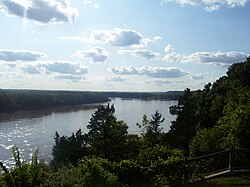
Missouri is home to a diversity of flora, fauna and funga. There is a large amount of fresh water present due to the Mississippi River, Missouri River, and Lake of the Ozarks, with numerous smaller rivers, streams, and lakes. North of the Missouri River, the state is primarily rolling hills of the Great Plains, whereas south of the Missouri River, the state is dominated by the oak-hickory Central U.S. hardwood forest.
Contents
Some of the native species found in Missouri are included below. [1] [2]